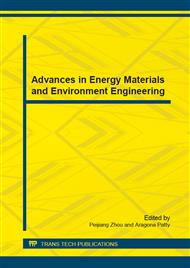p.211
p.216
p.220
p.225
p.230
p.235
p.239
p.245
p.249
Removal of Zinc Ions from Aqueous Solutions by Micro-Electrolysis and Iron Hydroxide Self-Flocculation
Abstract:
This study was performed to determine the feasibility of enhancing removal of zinc ions from aqueous solutions using an iron-carbon internal micro-electrolysis (ICIME) followed by iron hydroxide self-flocculation (IHSF) process. Results shown that the Zn2+ removal using ICIME was improved by IHSF significantly. The pH=3, mass ratio of Fe/AC=2: 1, hydraulic reaction time=30min of ICIME and pH=9, both aeration time and static placing time were 60min of IHSF were proposed as the optimum conditions. Under these conditions, the removal efficiency and residual concentration of Zn2+ from lead and zinc smelting wastewater were reached 99.10%, 1.32mg/L. Meanwhile, other metal ions and the F- also were removed effectively. Lead and zinc smelting wastewater could meet the discharging standard (integrated wastewater discharge standard (GB8978-1996)) of China. The Zn2+ removal was significantly influenced by other metal ions existing in aqueous solutions. Contrast and breakthrough time experiment indicated the Compare with single Fe and ICIME, ICIME followed by IHSF have a higher efficiency and bearing capacity for Zn2+ removal. ICIME removal of Zn2+ enhanced by IHSF is a feasible method.
Info:
Periodical:
Pages:
230-234
Citation:
Online since:
December 2014
Authors:
Keywords:
Price:
Сopyright:
© 2015 Trans Tech Publications Ltd. All Rights Reserved
Share:
Citation:


